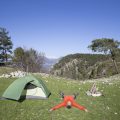Understanding Leave No Trace Ethics
When heading into the backcountry, practicing Leave No Trace (LNT) isn’t just a nice idea—it’s essential. These ethics help preserve the wild places we love, making sure they stay healthy and beautiful for future generations. The Leave No Trace Center for Outdoor Ethics outlines seven core principles that guide our behavior in nature. They’re not rules, but rather a set of practices that help us minimize our impact.
Why Leave No Trace Matters
Backcountry environments are often fragile and remote. Once damaged, recovery can take decades—or may never fully happen. By following LNT principles, we reduce our footprint, avoid disturbing wildlife, and respect others who are out there seeking solitude or adventure.
The Seven Principles of Leave No Trace
| Principle | What It Means |
|---|---|
| 1. Plan Ahead and Prepare | Know the area, weather, regulations, and pack accordingly to reduce risks and environmental damage. |
| 2. Travel and Camp on Durable Surfaces | Stick to established trails and campsites to prevent soil erosion and habitat destruction. |
| 3. Dispose of Waste Properly | “Pack it in, pack it out”—carry out all trash, leftover food, and litter. Use catholes for human waste if needed. |
| 4. Leave What You Find | Don’t take rocks, plants, or historical artifacts. Let others enjoy the same discoveries you did. |
| 5. Minimize Campfire Impact | If fires are allowed, keep them small and use established fire rings. Better yet, use a camp stove. |
| 6. Respect Wildlife | Observe from a distance—never feed animals or disturb their natural behaviors. |
| 7. Be Considerate of Other Visitors | Keep noise down, yield on trails, and maintain space so everyone can enjoy the outdoors peacefully. |
Respecting Wildlife and Others
A big part of LNT is understanding that we’re visitors in someone else’s home—the wildlifes. Give animals plenty of space and never try to approach or feed them. Even small interactions can cause stress or change their behavior in harmful ways. Also remember to be courteous to other people on the trail or at your campsite. We all go into nature for different reasons—some for quiet reflection, others for adventure—but we share the responsibility of keeping it pristine.
The Ecological Integrity of the Backcountry
The backcountry is more than just a scenic escape; its a delicate ecosystem where every plant, animal, and water source plays a role. Trampling off-trail may seem harmless in the moment but can crush fragile vegetation or disrupt soil systems that took years to develop. LNT encourages us to make choices that protect these natural processes so that these wild spaces remain wild.
Quick Tips for Practicing LNT in the Backcountry
- Check local regulations: Fire bans? Bear canisters required? Know before you go.
- Avoid peak times: Less crowding helps both nature and your experience.
- Use reusable gear: Cut down on single-use plastics by packing smart.
- Stay mindful: Every step and decision matters—think about its impact.
The more we understand Leave No Trace ethics, the better stewards we become of the lands we explore. Whether youre out for a weekend hike or a week-long backpacking trip deep in the wilderness, these principles offer simple ways to do your part in protecting Americas natural treasures.
2. Backcountry Planning and Preparation
Before you hit the trail, a little planning goes a long way—especially when it comes to leaving no trace in the backcountry. From picking a campsite to organizing your group, every decision can impact the environment and your experience. Heres how to plan smarter and tread lighter.
Choose Low-Impact Campsites
Not all campsites are created equal. When selecting a spot to pitch your tent, aim for areas that are already established or show signs of previous use. Avoid pristine areas where your presence could cause lasting damage. Stick to durable surfaces like rock, gravel, dry grass, or snow.
What to Look for in a Campsite:
| Feature | Why It Matters |
|---|---|
| Established site | Prevents further disturbance of vegetation and soil |
| Durable surface | Minimizes erosion and wear on sensitive ground |
| 200 feet from water sources | Protects fragile riparian zones and prevents contamination |
| Sheltered from wind/weather | Keeps your group safe and reduces need for altering surroundings |
Manage Group Sizes Wisely
Larger groups have bigger footprints—literally. If youre heading out with more than 6–8 people, consider splitting into smaller subgroups and traveling separately. This reduces crowding at campsites and trail congestion, which helps preserve the wilderness feel for everyone.
Tips for Group Travel:
- Set clear expectations about Leave No Trace principles before departure.
- Designate roles (navigator, safety lead, camp chef) to stay organized.
- Stagger hiking times if trails are narrow or heavily used.
Plan for Safety Without Overpacking
A well-prepared backpacker is not only safer but also less likely to make damaging decisions under stress. That said, overpacking can slow you down and tire you out quicker. Focus on essentials: navigation tools, extra food and water, first-aid kit, weather-appropriate gear, and emergency communication devices.
Packing Checklist Essentials:
| Category | Examples |
|---|---|
| Navigation | Map, compass, GPS device/app (with offline maps) |
| Shelter & warmth | Tent/tarp, sleeping bag, thermal layers, rain gear |
| Food & hydration | High-calorie snacks, freeze-dried meals, water filter/purifier |
| First Aid & safety gear | Basic kit, headlamp with batteries, whistle, multitool |
| Communication & info backup | Emergency beacon or satellite messenger; printed itinerary left with someone at home |
Avoid Unexpected Disruptions on the Trail
You cant control everything in the backcountry—but you can reduce surprises by checking weather forecasts, knowing wildlife activity in the area, understanding fire restrictions, and reviewing local regulations. Always have a backup plan in case a trail is closed or conditions change quickly.
Quick Planning Tips:
- Download offline maps before you lose service.
- Check with rangers about current trail conditions or closures.
- Create a trip plan and share it with someone you trust.
- If plans change mid-trip, stick to Leave No Trace principles wherever you go.
The better you plan ahead for your backcountry trip, the more youll enjoy it—and the less impact youll leave behind.

3. Low-Impact Travel and Camping Techniques
Exploring the backcountry is an incredible way to connect with nature, but its important that we do so in a way that preserves these wild places for future generations. Practicing low-impact travel and camping techniques is a key part of the Leave No Trace (LNT) philosophy. Heres how you can reduce your footprint while enjoying your outdoor adventures.
Traveling on Durable Surfaces
Whenever youre hiking or moving through the backcountry, stick to durable surfaces like established trails, rock, gravel, dry grass, or snow. These surfaces can handle foot traffic without being damaged. Avoid stepping on fragile vegetation, soft soil, or cryptobiotic crusts found in desert environments—they can take years to recover from a single footprint.
| Surface Type | Durability Level | Recommended Action |
|---|---|---|
| Rock / Gravel | High | Safe to walk on |
| Dry Grass / Snow | Moderate | Avoid if alternatives exist |
| Moss / Wet Meadow / Desert Crust | Low | Avoid at all times |
Selecting a Discreet Campsite
Your campsite should blend into the environment. Choose spots that are already impacted—like established campsites—or areas without vegetation where your presence won’t cause further damage. Stay at least 200 feet away from lakes, streams, and trails to protect water sources and maintain solitude for others.
Campsite Do’s:
- Pitches on durable surfaces like gravel or sand
- Away from water sources (at least 200 feet)
- Sheltered from wind but not under dead trees or branches
- No digging trenches or altering the site permanently
Campsite Don’ts:
- No clearing vegetation to make space for tents
- No building structures or furniture with natural materials
- No creating new fire rings if one already exists nearby
Minimizing Campfire Impact
If campfires are allowed in your area, keep them small and controlled. Use existing fire rings whenever possible. Better yet, consider using a lightweight backpacking stove—it’s efficient and leaves no trace. If you must build a fire, use only dead and downed wood that’s smaller than your wrist. Burn everything to ash and scatter cool ashes far from camp.
Campfire Alternatives:
- Candle lanterns: Provide cozy light without smoke or sparks.
- Chemical hand warmers: Safe heat source during cold nights.
- Solar-powered lights: Rechargeable and eco-friendly options.
Avoiding Damage to Fragile Ecosystems
The backcountry is filled with delicate habitats that can be easily harmed by careless actions. Whether it’s alpine tundra, wetlands, or desert biocrusts, these ecosystems require special care. Always research the area youre visiting ahead of time to understand its sensitivities. Stay on designated paths, avoid shortcuts across switchbacks, and educate others about the importance of preserving these special places.
The goal of low-impact travel and camping is simple: enjoy nature without leaving a mark. By following these guidelines, you help protect wild spaces so they remain wild—not just for us, but for everyone who comes after us.
4. Waste Management in the Wild
Proper waste management is a key principle of Leave No Trace, especially when youre deep in the backcountry. When we take care of our trash and waste correctly, we help protect fragile ecosystems, keep water sources clean, and prevent wildlife from becoming dependent on human food.
Human Waste: Go Responsibly
When nature calls and there’s no toilet around, it’s important to know how to go in a way that minimizes impact:
Cat Holes
For most remote areas, digging a cat hole is the standard method for disposing of human waste. Here’s how to do it right:
- Dig 6-8 inches deep and 4-6 inches wide.
- Choose a spot at least 200 feet away from water sources, trails, and campsites.
- Cover the hole with natural materials after use.
Packing Out Toilet Paper
Used toilet paper should always be packed out in a sealed plastic bag or odor-proof container. Even if it seems biodegradable, it doesn’t break down quickly in cold or dry environments.
WAG Bags
In some areas where digging isn’t allowed or safe (like alpine zones or deserts), you’ll need to use a WAG bag—a portable toilet kit that allows you to pack out your waste safely and legally.
Trash: Pack It In, Pack It Out
No matter how small it seems—candy wrappers, twist ties, orange peels—everything needs to be packed out. If you brought it in, take it back out. Always carry an extra ziplock or trash bag for your garbage.
Food Scraps: Not Wildlife Food
Leftover food and scraps attract animals and can make them sick or aggressive. That includes tiny crumbs! Use these tips:
- Sweep up every crumb before leaving your site.
- Strain dishwater to catch food bits and pack them out.
- Use unscented soap at least 200 feet from any water source when cleaning dishes.
Bear-Proofing Your Food & Trash
In bear country (which includes much of the U.S. backcountry), using proper food storage is not just smart—it’s often required by law. Heres a quick comparison of common storage methods:
| Method | Description | Best For |
|---|---|---|
| Bear Canister | A hard-sided container that bears can’t open; required in many national parks. | High-risk bear areas; solo or small group trips. |
| Bear Bag + Hang System | A durable sack hung from a tree branch using the PCT method or similar. | Lighter-weight option; requires trees and practice to hang properly. |
| Ursack (bear-resistant soft bag) | Tough fabric bags that resist tearing; must be tied securely to something solid. | Lighter than canisters; easier than hanging; approved in some regions. |
Leave It Better Than You Found It
If you find trash left behind by others, consider packing it out too. Being part of the solution helps preserve wild places for everyone who follows—and keeps true to the spirit of Leave No Trace.
5. Real-Life Scenarios and Problem-Solving
When youre out in the backcountry, real-life situations can test your Leave No Trace (LNT) knowledge. Its one thing to know the principles — its another to apply them when nature throws you a curveball. Let’s break down some common scenarios and how to make smart, ethical choices on the spot.
Encountering Wildlife
Imagine you’re hiking and suddenly spot a black bear near your trail. Its exciting but also potentially dangerous. Heres how to handle it:
| Do | Dont |
|---|---|
| Stay calm and slowly back away | Approach for a closer photo |
| Keep food stored properly using bear-proof containers | Leave snacks or trash behind |
| Observe from a safe distance (at least 100 yards) | Try to feed or interact with the animal |
Following LNT means respecting wildlife by giving them space and keeping them wild — dont let your actions change their behavior.
Crowded Campsites
You arrive at your planned campsite only to find its already full. It’s late, and you’re tired. What now?
Smart LNT-Friendly Options:
- Look for durable surfaces nearby: Camp on rock, gravel, dry grasses, or snow instead of delicate vegetation.
- Avoid expanding the site boundaries: Don’t create new fire rings or clear more space.
- Consider moving on: If nothing looks suitable, hike a bit further until you find a proper site that follows LNT guidelines.
Avoid These Mistakes:
- Setting up camp too close to water sources (stay at least 200 feet away).
- Trampling plants just to squeeze into a crowded area.
- Leaving visible signs of your stay like toilet paper or food scraps.
Sudden Weather Changes
You’re halfway through a backpacking trip when dark clouds roll in fast. Rain starts pouring, trails turn slippery, and visibility drops. Here’s how to react responsibly:
LNT-Aligned Response Plan:
- Shelter smartly: Use natural cover or set up temporary shelter without damaging trees or digging trenches.
- Avoid fragile areas: Don’t trample wet meadows or muddy slopes — this leads to erosion and long-term damage.
- Wait it out if needed: Stay put until conditions are safer instead of rushing through sensitive terrain.
LNT isn’t about perfection — it’s about making thoughtful decisions even under pressure. The more you practice these responses, the more natural they become in real life.
Your Role in Backcountry Ethics
No matter what situation arises, remember: every decision matters. Whether youre managing waste during a storm or choosing where to pitch your tent after sunset, use Leave No Trace as your compass. Its not just about protecting nature today — its about making sure others can enjoy it tomorrow.
6. Building a Leave No Trace Mindset
Practicing Leave No Trace (LNT) is more than just following a set of rules—its about adopting a mindset that helps protect the wild places we love. When you develop this mindset, you become not only a better camper or hiker but also a role model and advocate for preserving the backcountry for future generations.
Lead by Example
The easiest way to inspire others to follow LNT principles is by living them out yourself. Whether its packing out your trash, staying on designated trails, or minimizing campfire impact, your actions speak louder than words. People notice, especially new hikers who are still learning the ropes.
Everyday Behaviors That Make an Impact
| Action | LNT Benefit |
|---|---|
| Pack out all trash, even micro-trash like food wrappers | Keeps natural areas clean and reduces wildlife attraction to human food |
| Use established campsites and trails | Prevents erosion and habitat destruction |
| Respect wildlife by keeping distance | Protects animals from stress and preserves natural behavior |
Educate Fellow Hikers
You dont need to be a park ranger to help others learn about Leave No Trace. Simple conversations on the trail or at the trailhead can go a long way. If you see someone unknowingly doing something harmful—like feeding wildlife or carving into trees—gently offer guidance rather than criticism.
Tips for Sharing LNT Knowledge
- Start with curiosity: Ask if they’ve heard of Leave No Trace before sharing tips.
- Be friendly and non-judgmental in your tone.
- Share personal stories or reasons why LNT matters to you.
- Carry extra waste bags to hand out when needed.
Be an Advocate for Conservation
Your LNT mindset can extend beyond the trail. Support local and national organizations that protect public lands. Volunteer for clean-up events or donate to groups working on conservation efforts. Speak up when land use policies are being discussed in your community.
Ways to Advocate Off the Trail:
- Attend public meetings about outdoor recreation and land use policies.
- Write letters to local representatives supporting conservation initiatives.
- Support brands and businesses that promote sustainable practices.
- Join or donate to conservation-focused nonprofits like the Leave No Trace Center for Outdoor Ethics.
By building a Leave No Trace mindset, youre doing more than protecting nature—youre creating a culture of respect and responsibility in the outdoors that will ripple across generations of adventurers to come.


